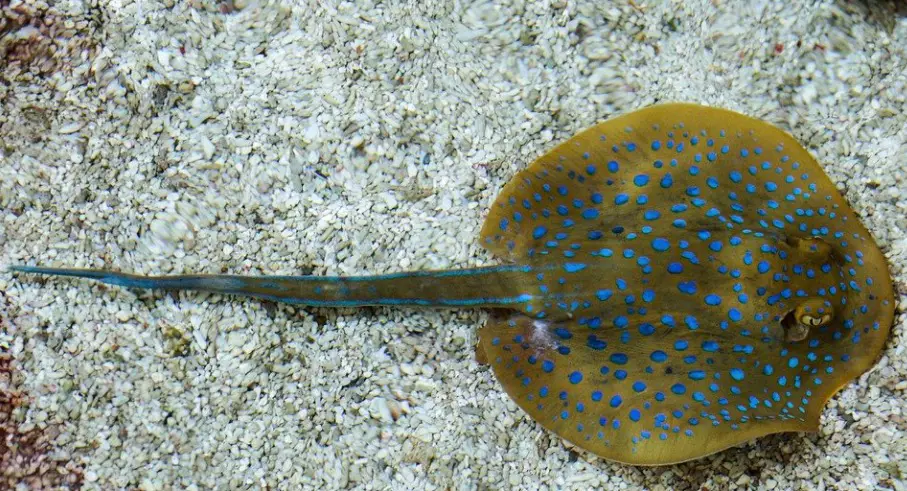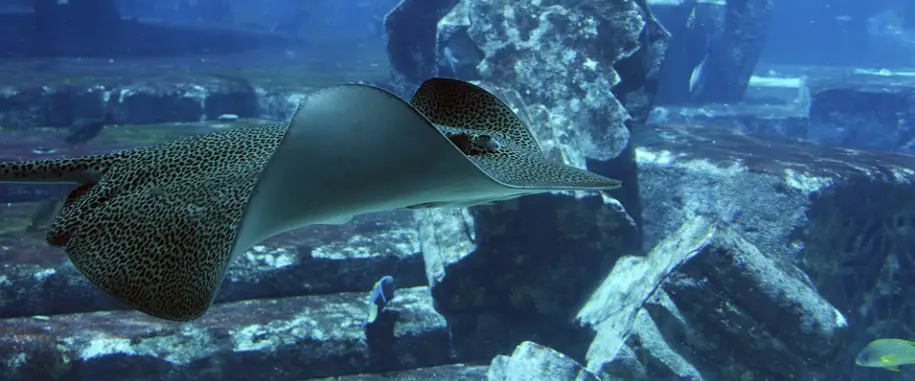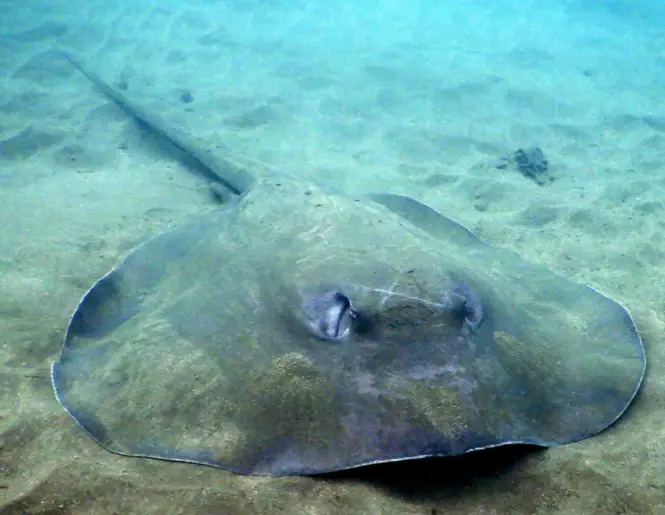Table of Contents
Stingray: All You Need To Know
The stingray is a carnivorous fish which belongs to the kingdom of Animalia, phylum Chordata, and class Chondrichthyes. It has 29 genera and approximately 220 species. Its length can reach 2 m and it weighs up to 358 kg. It lives on the ocean floor with a lifespan of up to 15 to 25 years.

What is Stingray?
The stingray is a cartilaginous fish that can be found in temperate, tropical freshwater and marine habitats around the world. These fish belong to the order Myliobatiformes and are closely related to sharks. Instead of sharp teeth like sharks, some species have a pointed tip at the end of their tail that can be used to stab potential predators. These prongs are poisonous.

The rays have a flattened body with a long pectoral fin and tail. Its colouring often reflects the shadow of the ocean floor, allowing it to blend in and hide from predators such as sharks. Its eyes are located on the dorsal (upper) side, while the parsnip’s mouth, gills, and nostrils are located below its abdomen.
These cartilaginous fish use their pectoral fins to move around. Most rays swim, moving their bodies like a wave, while others flap their fins like wings. Their tails can be used to help them navigate the water.

Like sharks, rays have electrical sensors called Lorenzini bulbs. These organs are located near the parsnip’s mouth and sense the natural electrical charges emitted by other animals. Many species of stingrays also have upper molars that they use to crush shellfish such as clams, mussels, and oysters.

When laying eggs, the male flirts with the female by following and biting her pectoral disc. Stingrays reproduce sexually when the male inserts one of his hooks into his vent. The breeds are ovoviviparous, which means that they give birth to live young. The litters ranged from 5 to 13 puppies.
Embryos develop in the uterus of a woman without a placenta. Instead, the embryos have a yolk sac to absorb the nutrients they need, and then the mother delivers milk to the uterus. After birth, the young usually separate from the mother and swim away and do not need the mother’s care.
There are some exceptions to this, such as the freshwater giant parsnip (Himantura chaopraya), where the mother catches the young and swims with them until they reach nearly a third of their size.

The races are considered threatened and several species are listed by the IUCN as vulnerable and threatened. The main threats to the rays are habitat loss, overfishing and climate change. The main threat is overfishing, as the stingrays are not only harvested for their meat, but also for the gills used in traditional Chinese medicine.

Stingray Families
1. Hexatrygondae (sixgill stingray) -This family has only one species, the sixgill stingray, which has six gills as its name indicates. The ray’s triangular snout and gill arches are another distinctive characteristic.
2. Plesiobatidae (deepwater stingray) – this family contains just one species, the deep-water stingray, also known as the gigantic stingaree. This stingray may be found at a depth of nearly 2,200 feet (670.5 metres).
3. Urolophidae (stingarees) – these tiny rays live in warm, shallow waters with sandy bottoms where they may burrow. This family consists of two genera and roughly 35 species.
4. Urotrygonidae (round rays) – the round rays have a circular body with a short tail and no dorsal fins, as the name implies. They are mostly found in the warm waters of the Caribbean Sea and along the North and South American shores.
5. Dasyatidae (Whiptail stingrays) receive their name from their tail, which is curved like a whip and possesses a poisonous barb on the end. The majority of whiptail species live in the sea, although some, like the Southeast Asian giant freshwater stingray, also live in rivers.
6. Potamotrygonidae (river stingrays) – freshwater stingrays found in tropical and subtropical South America’s rivers.
7. Gymnuridae (butterfly rays) – This family of rays has a flattened body and a shorter tail than other ray families, and they can become fairly large. Some butterfly ray species can grow to be up to 13 feet (4 metres) in length!
8. Myliobatidae (eagle rays) – unlike other ray families, Myliobatidae species are seen swimming in the open ocean’s pelagic zone and are frequently seen jumping out of the water. The common eagle, banded, mottled, and bat eagle rays are all notable species.
Fun Facts About Stingray!
Stingrays are a varied species of fish that live in both marine and freshwater environments. Stingrays are cartilaginous fish that are closely related to sharks and are most often seen in warmer waters.
They, like sharks, have been around for a long time and do not have a swim-bladder. Stingrays have a number of biological adaptations that have allowed them to survive for millions of years. Let’s have a look at it more closely!
Stingrays Have Venomous Barbs
While stingrays do not all have barbs on their tails, a substantial percentage of them do, and these barbs are poisonous! The barb is long and pointy, with numerous serrations pointing in the opposite direction, giving it the form of a Christmas tree. The barbs serve as a deterrent to would-be predators.
A venom gland in the barb injects venom into the stingray’s victim. The venom is highly powerful, including neurotoxins, enzymes, and the neurotransmitter serotonin, which slows blood circulation and inhibits smooth muscle contraction, preventing the venom from being diluted. Stingrays are typically calm, placid creatures who will not attack unless provoked.
Humans, on the other hand, are the most prevalent victims of fish-related injuries. When swimming in an area where stingrays are known to live, people should exercise caution. Although stingray stings are seldom deadly, they may be exceedingly painful. When strolling in shallow seas where these rays live, one method to avoid this is to shuffle your feet on the sand.
This will alert them to your presence, allowing you to avoid walking on them and getting injured by their barbs. If you are stung, treat the wound with hot water and seek medical attention right away.
Stingray Were Alive During the Jurassic
Stingrays are estimated to date back over 150 million years to the Jurassic Period, implying that they predate dinosaurs! Fortunately, their teeth and scales may fossilise, allowing scientists to determine how long they have existed.
However, because their skeleton is made of cartilage, which does not fossilise, finding a full skeleton is unusual. Stingray fossils are abundant, particularly preserved teeth, although just a few entire stingray fossils have been discovered.
Stingray and Buoyancy
Stingrays, unlike other fish, lack a swim bladder, which keeps them buoyant when they aren’t swimming. As a result, when they aren’t swimming, they begin to sink. They glide across the water using the flattened form of their bodies and their pectoral fins.
Because of their body shape and absence of a swim-bladder, they may sink to the ocean floor and hide in the sand from predators. This aids the stingray’s energy conservation. Several other fish species, including the stingray’s close cousin, the shark, lack a swim-bladder.
Stingray Have Spiracles
Stingrays, like other fish, breathe underwater, yet unlike fish, they don’t take water in via their mouths and pump it out through their gills. Stingrays, on the other hand, have spiracles, which are gas exchange apertures.
The stingrays use these holes, which are positioned behind their eyes, to take in water. The water is then pushed via their gills on the underside of their bodies. Because it does not need to take in water, the stingray’s mouth is free to consume. The stingray can even breathe while buried in the sand because of its adaptation.
Stingray Citations
- Stingray spear injury to the pediatric spinal cord: case report and review of the literature. Childs Nerv Syst . 2020 Aug;36(8):1811-1816.
- Stingray injuries. Wilderness Environ Med . 1997 Feb;8(1):24-8.
- Stingray Sting. PMID: 30969607







